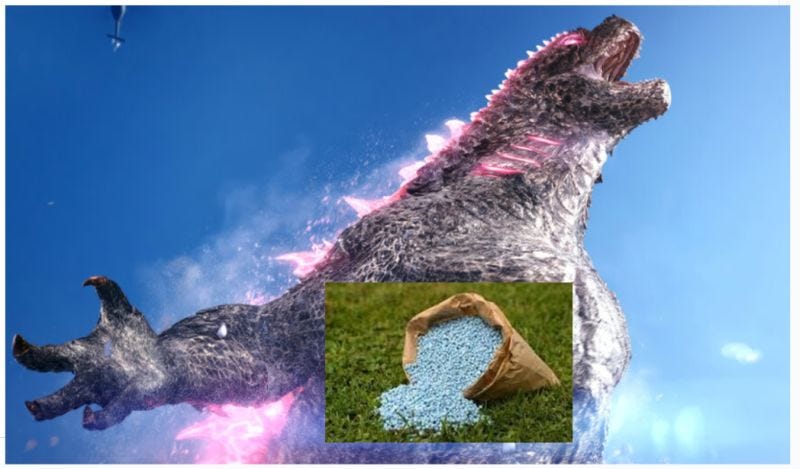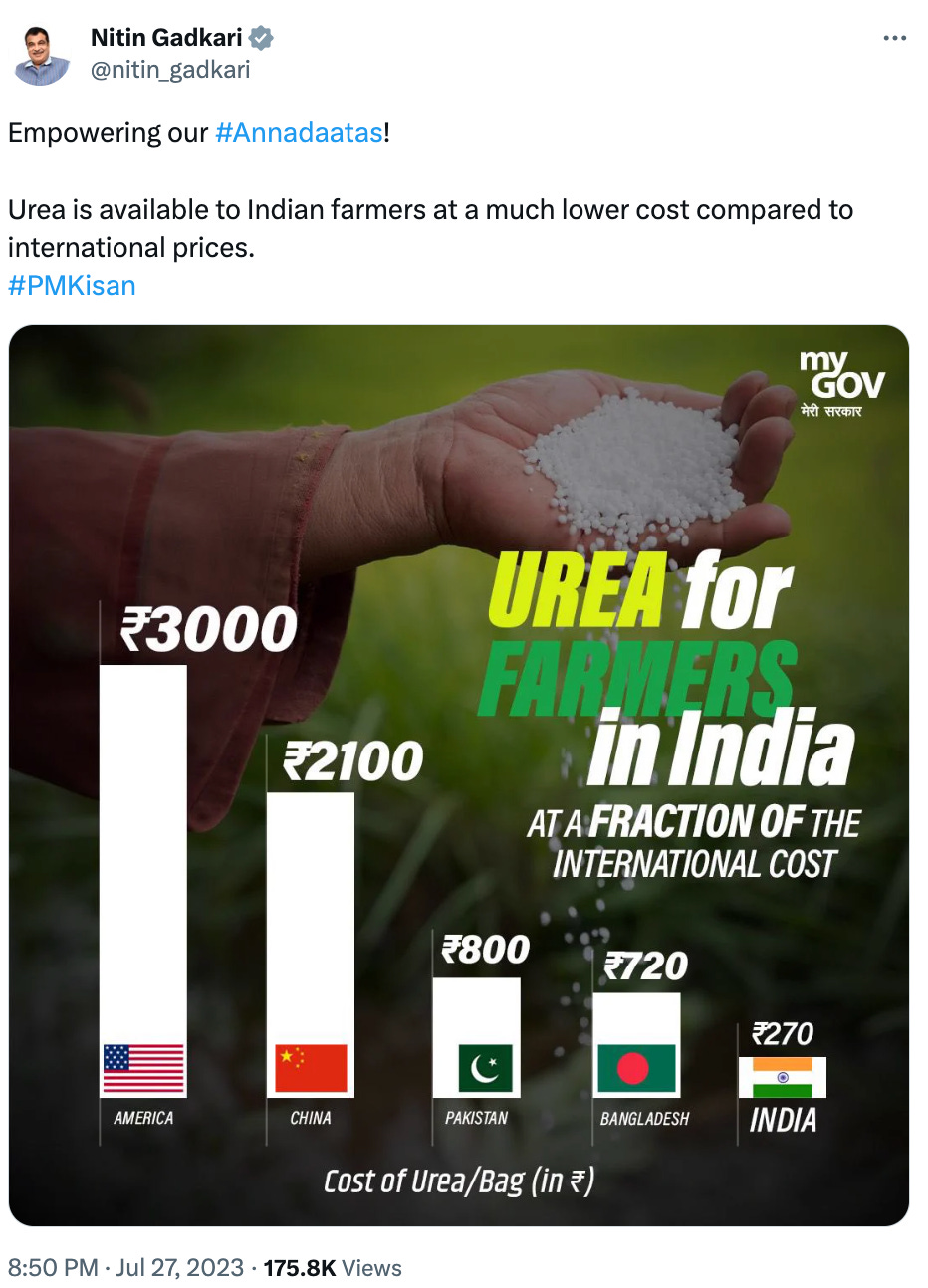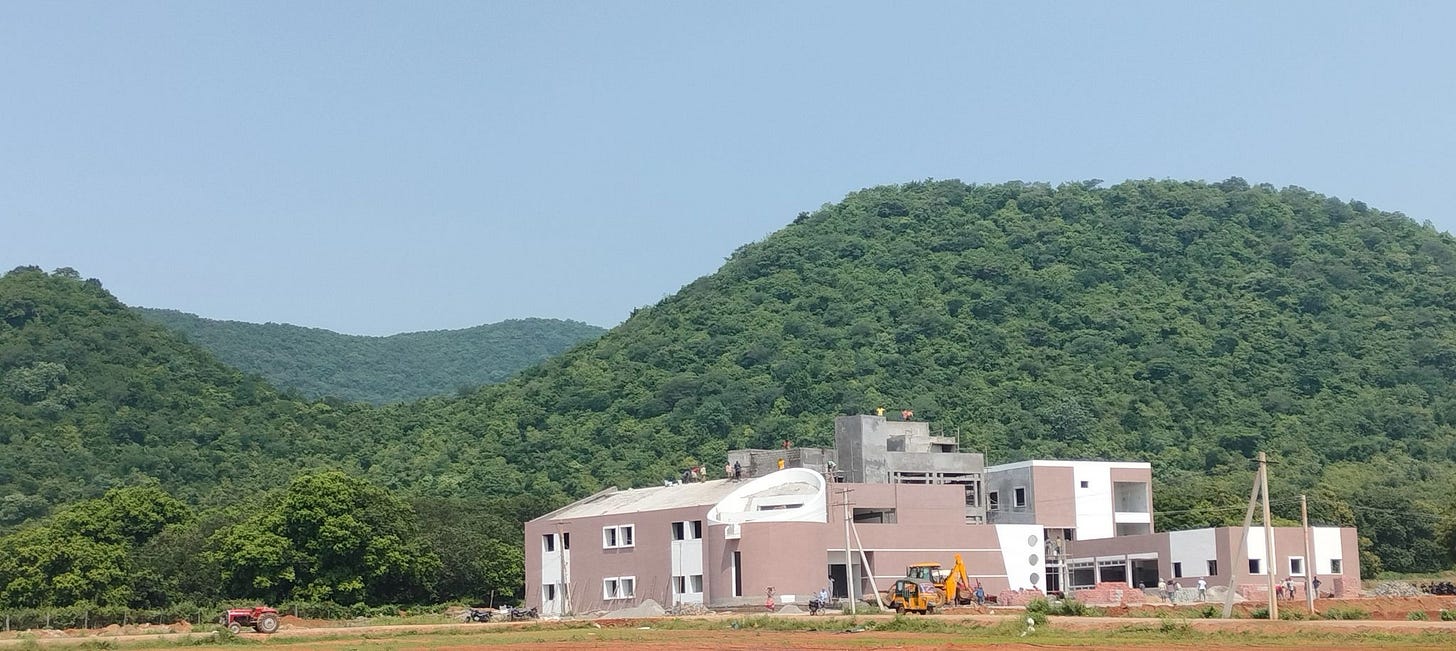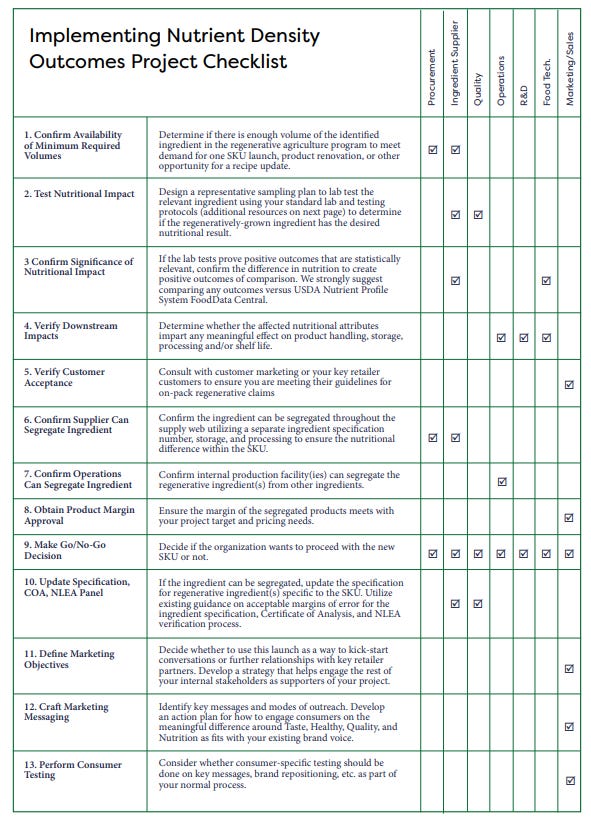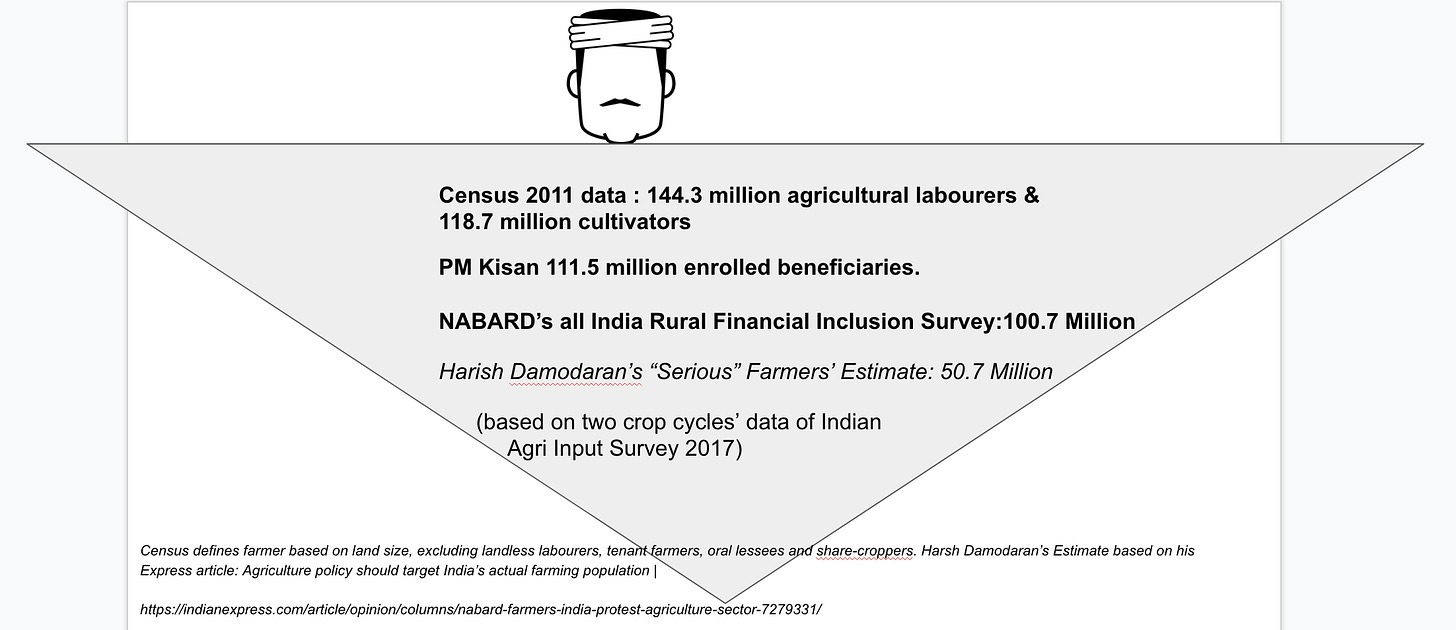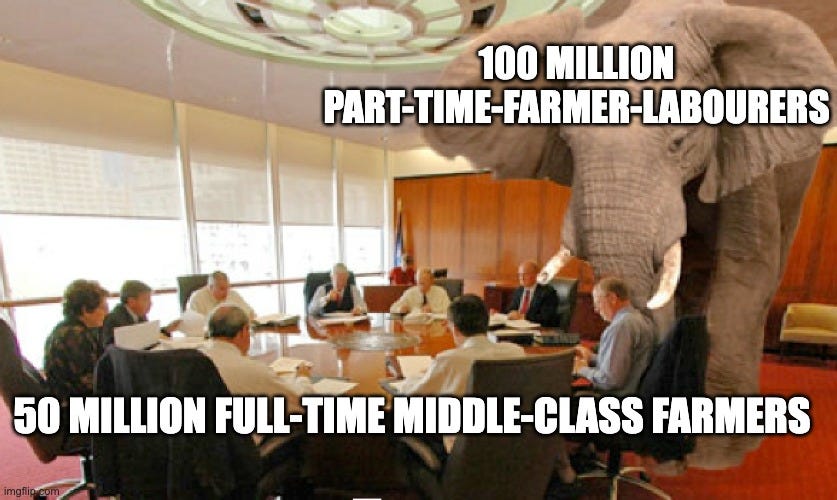Regenerative Agriculture Goes Mainstream
State of Agritech - 30th June 2024
In Today’s Edition:
1/ Tackling the Godzilla monster called Fertilizer Subsidy
2/ Regenerative Agriculture Goes Mainstream
Whether you call it “Regenerative Agriculture” or “Organic Agriculture” or “Agroecology”, the reading on the wall is clear: Transition is inevitable.
3/ Indian Agriculture’s Epochal Moment
Would you believe me if I told you that Indian Agriculture is on the verge of an epochal shift and nobody is talking about it with the seriousness it entails?
4/ Interpreting Mahindra’s Q4 2024 Results
5/ Reimagining Industrialization with Food Systems
6/ Inside the Coffee Industry’s Broken Value Distribution System
Programming Note: Stripe has been making changes to its Indian accounts and hence a lot of my international subscription accounts have been performing seppuku and self-cancelling themselves. I am getting this resolved with their support team.
Please bear with me until I get back with further steps. If Stripe pulls the plug, I might shift to alternative platforms and desert Substack and experiment with newer ideas. I am refraining from conducting ABM Townhall events and publishing subscriber-only notes until then. Your head over-heels support to Agribusiness Matters means a lot to me:
1/ Tackling the Godzilla monster called Fertilizer Subsidy
In Japanese cinema, Godzilla is an iconic symbol of unintended consequences and the more I think about fertilizer, I cannot stop wondering about the parallels.
Did you know that India's fertiliser subsidy (Rs 1.88 trillion (revised budget estimate of FY24) is now more than the total budget of the Indian agriculture ministry (Rs.1.25 trillion)?
I am not kidding. Few days ago, I learned this and my mind has been going bonkers.
Here is the cherry on the cake: The Ministry of Chemicals and Fertilisers Agriculture manages the fertiliser subsidy. Unlike EU and US, where the subsidy is given to farmers directly, in the case of India, the prices of fertilisers are artificially decreased while increasing the floor purchase price of crops, resulting in market distortions of Godzilla proportions.
Mind you, what we are seeing is a classic case of a Principal (Ministry of Finance)- Agent (Ministry of Agriculture) Problem of Godzilla proportions
At Agribusiness Matters, my long-term mission is to build a corpus of work that explores food and agriculture from a systems thinking lens.
Here is a fascinating case study.
Ministry of Chemicals and Fertiliser is pinning hopes that India will produce around 440 million bottles of nano urea by 2024-25 and after 2025, India need not import urea as domestic production of conventional and nano liquid urea could be sufficient to meet domestic demand.
There is only one catch.
Agronomists aren't yet fully convinced about nano urea's potential in the Indian Agricultural context and a quiet sea of dissent has been brewing in several academic and ground-truthing agronomy circles.
With international fertiliser prices escalating and even countries like China which produces 50 Million tonnes of Urea annually announcing an informal ban on the export of urea, the government is also aiming to cut down fertiliser subsidies through multiple fronts.
1) PM-Pranam Scheme- grant based on the saving of fertiliser subsidy that is generated when farmers switch to natural farming
2) Natural Farming Mission (which is expected to be announced in the upcoming budget)
3) Incentives to setup bio-resource centres across villages, enabling rural entrepreneurs to sell bio-fertilisers
Urea imports decreased from 9.83 million tons in 2020-21 to 9.13 million tons during 2021-22 and further down to 7.48 million tons during 2022-23. The impetus to reduce fertiliser subsidy is also coming from WTO which wants to repurpose agricultural subsidies towards climate proofing and sustainability.
Agriculture is a fascinating multi-dimensional, multi-agent domain that penalizes you for one-dimensional success and you end up being trapped in a perverse game of incentives.
Plants only absorb more than 35-40% of the nitrogen supplied. The rest get emitted into the environment as nitrous oxide, which is 273 times carbon equivalent.
Wait a Minute. Are we subsidising urea to increase nitrous oxide emissions?
Indian Government, I hear, is keen to explore jurisdictional credits, through partnership with the Environmental Defense Fund to help farmers earn carbon credits by minimising nitrous oxide emissions through bio-fertiliser, natural farming and other practices.
“The problem with organic fertilisers is that they require a lot of labour to prepare and then apply. Substituting one quintal of chemical 4:2:1 NPK requires one tractor-trolley of manure and three applications of bioculture. The cost of the labour required for the latter is many times more than the former. That is why organic farming isn't taking off.”- Rahul Banerjee
How do we tame this Godzilla Monster and increase support for farmers to transition towards regenerative agriculture and tackle the challenge transition entails? We will explore further.
2/ Regenerative Agriculture Goes Mainstream
Last week, I visited the newly built Krishna Sudha Academy of Agroecology and spent a day there. It is the third centre in the world, I was told by the Founder Executive Director, dedicated to agroecology after the Rodale Institute in the US and the Research Institute of Organic Agriculture FiBL in Europe.
As their website puts it, a"transdisciplinary research and education centre working on agroecology as an alternative paradigm for food, farming and livelihoods in a growing ecological, economic, and social crisis."
The gorgeous campus set in the backdrop of hills and mango orchards can accommodate eighty students and I also attended a session in the ongoing course that was being organized in Hindi for participants from Indian states of Odisha and Uttarakhand on "Extension Services for Organic/Natural Farming". The participants were a passionate lot, deeply committed to reversing the soil and health crisis unfolding in the Global South.
Equipped with state-of-the-art research facilities for MRL testing, seed banks, soil tests, and preparation of mother culture for bio-fertilizers and food processing, the founder has grand plans for this place with dreams of setting up a curated history museum that chronicles the innovations of Indian Agriculture and how far we've come.
When I read about Bayer’s experiments with regenerative agriculture; when I read Nutrition Density Alliance’s approach whitepaper outlining the integration of soil nutrition with health'; when I look at the regenerative agriculture commitments of 79 listed agri-food companies with a combined annual revenue of more than USD 3 trillion, I am now increasingly feeling convinced that Regenerative Agriculture has gone mainstream.
It doesn’t matter if you want to play political games, depending on your political stance and call it “Regenerative Agriculture” or “Organic Agriculture” or “Agroecology”, the reading on the wall is clear.
Transition is inevitable
Nutrient Density Alliance’s Paper neatly identifies four barriers in integrating soil health with nutrition
Confusion about how higher nutritional outcomes are quantified
Believing there is a lack of scientific evidence
Believing that additional studies are needed before taking action
The worry about marketing complicated soil science to engage consumers
One of the perennial joys of pursuing systems thinking in agriculture is exploring the parallels between humans and plants.
Human health is better appreciated by seeing the human body as a dynamic ecosystem thriving in cooperation with bacteria, fungi, archaea, viruses, protozoa, mites and worms.
Plant health is better appreciated by seeing the plant as a dynamic ecosystem thriving in cooperation with its microbiome, constantly relaying information through its microbiome on a real-time basis to decide what to do next.
With rainbowesque nutrient density approaches such as Foodomics, Periodic Table of Foods Inititiatve, Flavour Remedy, the future of “Food is health” (or if you prefer to call it “Food is Medicine”) is already here. It is just unevenly distributed.
What would it take to build an ecosystem that can scale such rainboweque nutrition density approaches? We will explore further.
3/ Indian Agriculture’s Epochal Moment
Epochal moments, if history is any indicator, tend to pass by quietly. Would you believe me if I told you that Indian Agriculture is on the verge of an epochal moment and nobody is talking about it with the seriousness it entails?
In September'21, a 12-digit unique ID for farmers (based on India's experiences with Aadhaar) and a unified farmer service interface were envisioned. The key aspect here is a National Farmers Database with details of this country's farmers linked with land records which could be shared and further leveraged by agritech and agribusiness firms across the country.
With Modi 3.0 now doubling their focus on rural India, after being stung by the results in the rural electorate, assuming all the implementation challenges will be addressed, this plan is most likely to be implemented at scale.
Why is a 12-digit unique ID for Indian farmers an epochal moment with repercussions that could fundamentally change the nature of Indian Agriculture forever?
There is no single definition of Indian Farmer for good and bad reasons. Everybody knows the bad reasons - leakage, inefficiency and exploitation in various forms. What are the good reasons?
When governments want to provide welfare support to farmers, they could do so via price-based intervention or income-based intervention.
Currently, price-based intervention (such as MSP) plays a bigger role than income-based intervention because when governments do price-based intervention, you don’t have to identify who a farmer is.
If you look at the total count of Indian farmers based on different definitions and policies, you will understand what I am talking about.
I can go on with other definitions and you will see how the numbers vary significantly. (For technologists reading this, this is a fascinating ontology problem begging to be solved)
As we saw in today’s edition, there are enough clues now that the Indian government wants to focus on income-based intervention for curbing the outlay of the fertiliser subsidy and ushering technology to curb leakages.
I have talked a lot about how Indian Agriculture has many more labourers (who moonlight as farmers) than farmers.
Indian farmers live multi-hyphenate lives. Except for large landholding farmers, most Indian farmers maintain a diverse portfolio of incomes to keep their livelihoods intact while pursuing agriculture. Now what happens when a 12-digit unique id starts to enforce the "farmer" identity more strongly than other identities?
Today, the definitions of an Indian farmer are so fluid. What happens when these definitions harden? On the positive side, this move would help in precise delivery of schemes and welfare programmes. What are the unintended consequences that we are not thinking about? We will explore further.
4/ Interpreting Mahindra’s Q4 Results
TL;DR: Scaling operations, strategic investments, and targeting specific product categories to replicate their success in the tractor market.
Farm Machinery Growth and Strategy:
Performance in FY24: M&M aimed for a 40% growth in FY24 but achieved approximately 32%, which was considered disappointing due to market difficulties.
Future Projections: The company expects the tractor and farm machinery industry to recover starting FY25, anticipating good momentum in farm machinery sales and better pricing. They predict profitability within one and a half to two years but acknowledge that margins will take longer to reach tractor-level profitability.
Investment and Scaling: M&M plans to invest in pricing for the next few years to scale up their operations. They aim to leverage their market position to achieve significant growth and better pricing in the farm machinery sector.
Market Share and Product Strategy:
Rotavators and Harvesters: M&M has significantly increased its market share in rotavators from below 10% to 21%. They are targeting specific categories like harvesters, expecting a greater share in the upcoming crop cycle. The goal is to replicate their 40% market share in tractors across other categories.
Product and Distribution: Success in increasing market share is attributed to having the right products at the right price points, and, in some cases, using different distribution channels from their traditional farm dealerships.
Profitability and Market Conditions:
Profit Pools: Despite the current challenges, M&M observes that other farm machinery players operating at scale are achieving double-digit margins. This indicates a profitable potential once M&M scales up their operations.
Market Conditions: The outlook on commodity prices and market conditions has been mixed, affecting margins and growth. Nonetheless, M&M took strategic price increases and benefited from an improved product mix and benign commodity outlook, which helped margins.
5/ Reimagining Industrialization with Food Systems
The Gen-Z generation I often speak to, looks down upon industrialisation. What if we could reimagine industrialisation with food systems to make them much more inviting and of course, greener and inclusive?
This story of Anand Chordia and Suhana Spices warms the cockles of my heart as it pushes the boundary of how we could reimagine industrialisation and make the space more lively and vibrant with nature.
Here is the thing.
When you creatively integrate the food system with sustainable industrialization, you could embrace Zero-Waste, Zero Water and Zero Energy goals in such fascinating ways!! I wish more business leaders (outside the world of food and agriculture systems) take note of this amazing experiment and explore sustainability in meaningful ways!
6/ Inside the Coffee Industry’s Broken Value Distribution System
No surprises here in this report from global Impact Middlemen player Solidaridad Network
Value concentrates away from farmers and further down the value chain – from importer to retailer.
Family labour is undervalued. Labour is the largest share of farm costs for smallholders, but it is often unpaid and unaccounted for – meaning farmers’ “margins” can seem higher than they are which hides the problem.
There is no quick fix. Alongside important sector efforts to increase farmer profitability, it’s about creating value distribution mechanisms and enabling trading conditions that account for the diversity and complexity of the coffee industry. (From the Report)
Would regeneratively grown coffee, buoyed by success stories like Araku, change these structural dynamics? We will explore further.
So, what do you think?
How happy are you with today’s edition? I would love to get your candid feedback. Your feedback will be anonymous. Two questions. 1 Minute. Thanks.🙏
💗 If you like “Agribusiness Matters”, please click on Like at the bottom and share it with your friend.





